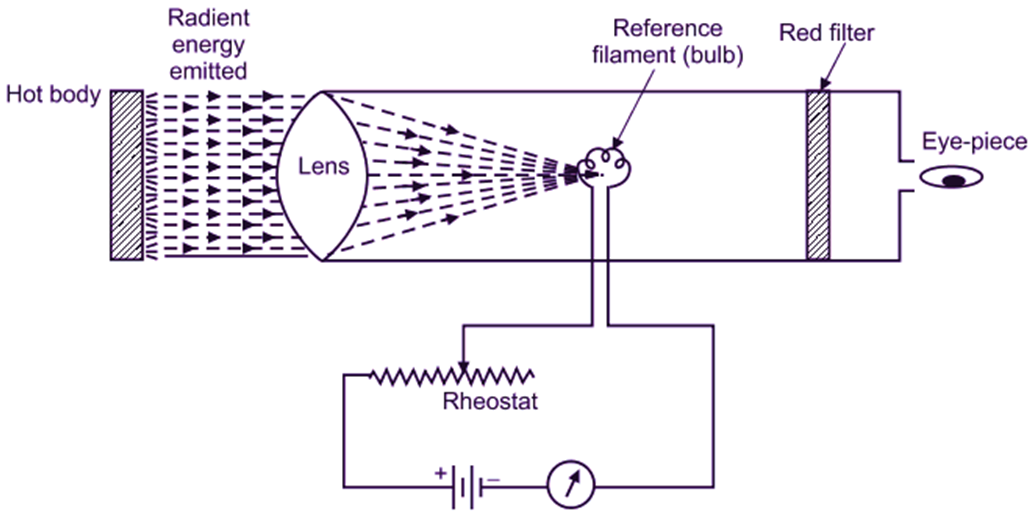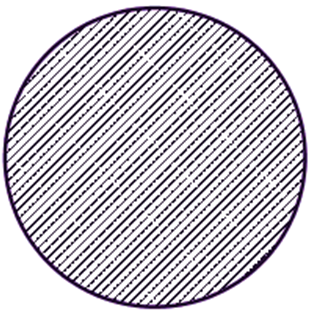Operating Range: Up to 1400°C, which can be extended up to 3000°C with the use of absorption type screen placed near the lens.
Working principle of Optical Pyrometer
It is based on comparisons of intensity (brightness) of visual radiation emitted by a hot body with the radiation energy emitted by a source of known intensity. Here, the intensity of radiation emitted by hot body, whose temperature is to be measured, is matched with the intensity of a reference filament (lamp), whose temperature is known.
Construction & Working of Optical Pyrometer
Optical pyrometer consists of a hot body, lens, filament lamp, red filter placed in one line (Fig. 1). Lens is used to pick up the radiant energy and to focus it on to the reference filament (lamp or bulb). In short, an image of radiating source is produced by lens and made to coincide with reference filament (lamp or bulb). Current through the reference filament (lamp or bulb) is varied to adjust the lamp intensity. The filament is Viewed through an eyepiece and a red filter.

Fig. 1: Optical Pyrometer
Current through the filament is adjusted until the filament image and image of radiating source are of equal brightness. This amount of current adjustment needed to match the images of two sources of light’s done with the help of rheostat. Current adjustment is nothing but the measure of temperature. Position of rheostat indicated on the dial is graduated in terms of temperature. Red filter is placed in between heating filament and eye-position of operator. Red filter acts as a protective barrier for capturing unwanted radiations, which can lead to eye diseases of operator.
Conclusions
When both, brightness of image produced by source and brightness produced by filament, are equal, the outline of filament will show a pattern as shown in Fig. 2 (a). But, if temperature of filament s higher than that required for equal brightness, then filament becomes too bright and it can be seen in Fig. 2 (b). If temperature of filament is lower than that required for equal brightness, then filament becomes too dark, which can be seen in Fig. 2 (c).

(a) Equal brightness

(b) Too bright

(C) Too dark
Fig. 1: Conclusions
Advantages of Optical pyrometer
- Optical pyrometer is portable.
- Fast response.
- It can measure the high temperature with accuracy.
- It is used to detect the temperature at distant place.
- It is less sensitive to changes in emissivity.
- It is used for very high temperatures (700°C to 3000°C).
Disadvantages of Optical pyrometer
- Device is very costly.
- More chances of human error, while adjusting the image.
- It measures the temperature of only hot surfaces.
- Non-linear in behaviour.
- Possible errors due to presence of intervening gases or vapours, which absorb radiations.
Applications of Optical Pyrometer
- Temperature measurement in furnace, molten metal, etc.
- Very high temperature applications of the order of 3000°C.
Difference Between Radiation Pyrometer and Optical Pyrometer
| Comparative point | Radiation Pyrometer | Optical Pyrometer |
| Temperature | More than 550°C. | More than 700°C and up to 3000°C. |
| Sensitivity | Fair. | Good (Better). |
| Calibration | By comparison with standard optical pyrometer. | Against standard tungsten strip lamp. |
| Accuracy | More. | Less. |
| Stability | Good (Better). | Fair. |
| Working | Radiant energy is focused by lens on hot junction of thermocouple. | Colour of hot body is compared with heating filament. |
| Output | Emf, which is calibrated to give temperature of hot body. | Colour, which is compared with heating filament, whose temperature is known. |
| Cost | Low. | High. |